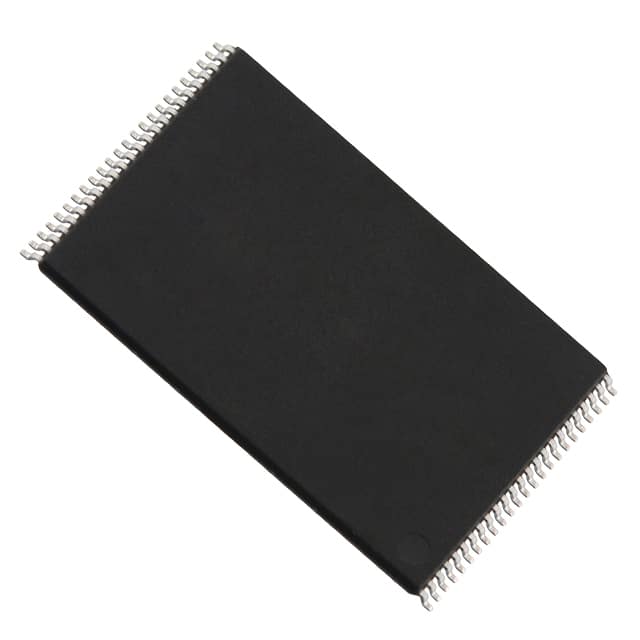M29F800DB70N6T TR
Product Overview
Category
The M29F800DB70N6T TR belongs to the category of non-volatile memory devices.
Use
This product is primarily used for storing and retrieving data in electronic systems, such as microcontrollers, embedded systems, and other digital devices.
Characteristics
- Non-volatile: The M29F800DB70N6T TR retains stored data even when power is removed.
- High capacity: This device has a storage capacity of 8 megabits (1 megabyte).
- Fast access time: It offers quick read and write operations, ensuring efficient data transfer.
- Low power consumption: The M29F800DB70N6T TR is designed to consume minimal power during operation.
- Wide temperature range: It can operate reliably within a wide temperature range, making it suitable for various environments.
Package
The M29F800DB70N6T TR is available in a surface mount package, which facilitates easy integration into circuit boards.
Essence
This memory device is essential for storing program code, data, and configuration settings in electronic systems, enabling them to retain information even when powered off.
Packaging/Quantity
The M29F800DB70N6T TR is typically packaged in reels or tubes, with each reel or tube containing a specific quantity of devices. The exact packaging and quantity may vary depending on the supplier.
Specifications
- Memory Type: Flash
- Capacity: 8 Megabits (1 Megabyte)
- Organization: 1M x 8
- Supply Voltage: 2.7V - 3.6V
- Access Time: 70 ns
- Interface: Parallel
- Operating Temperature Range: -40°C to +85°C
- Package Type: TSOP-48
Detailed Pin Configuration
The M29F800DB70N6T TR has a total of 48 pins, which are assigned specific functions. The pin configuration is as follows:
- A0 - Address Input
- A1 - Address Input
- A2 - Address Input
- A3 - Address Input
- A4 - Address Input
- A5 - Address Input
- A6 - Address Input
- A7 - Address Input
- A8 - Address Input
- A9 - Address Input
- A10 - Address Input
- A11 - Address Input
- A12 - Address Input
- A13 - Address Input
- A14 - Address Input
- A15 - Address Input
- CE - Chip Enable Input
- OE - Output Enable Input
- WE - Write Enable Input
- BYTE - Byte/Word Organization Input
- VCC - Power Supply
- DQ0 - Data Input/Output
- DQ1 - Data Input/Output
- DQ2 - Data Input/Output
- DQ3 - Data Input/Output
- DQ4 - Data Input/Output
- DQ5 - Data Input/Output
- DQ6 - Data Input/Output
- DQ7 - Data Input/Output
- RY/BY# - Ready/Busy Output
- RESET# - Reset Input
- WP# - Write Protect Input
- VSS - Ground 34-37. NC - No Connection
- RP - Reserved for Product Identification 39-46. NC - No Connection
- VPP - Programming Voltage
- NC - No Connection
Functional Features
The M29F800DB70N6T TR offers the following functional features:
- High-speed read and write operations
- Sector erase capability for efficient data management
- Automatic program and erase algorithms
- Hardware and software protection mechanisms
- Low power consumption during standby mode
- Reliable data retention for extended periods
Advantages and Disadvantages
Advantages
- Non-volatile memory ensures data retention even without power.
- High storage capacity allows for storing large amounts of data.
- Fast access time enables quick retrieval and modification of stored information.
- Wide temperature range makes it suitable for various operating environments.
Disadvantages
- Limited endurance: Flash memory has a finite number of erase/write cycles.
- Relatively higher cost compared to other types of memory.
- Larger physical size compared to newer memory technologies.
Working Principles
The M29F800DB70N6T TR is based on flash memory technology. It utilizes floating-gate transistors to store and retrieve data. When data is written, electrons are trapped in the floating gate, altering the transistor's behavior. To read the data, the transistor's behavior is analyzed by applying appropriate voltages. The M29F800
Senaraikan 10 soalan dan jawapan biasa yang berkaitan dengan aplikasi M29F800DB70N6T TR dalam penyelesaian teknikal
Sure! Here are 10 common questions and answers related to the application of M29F800DB70N6T TR in technical solutions:
1. What is the M29F800DB70N6T TR? - The M29F800DB70N6T TR is a specific model of flash memory chip manufactured by STMicroelectronics.
2. What is the capacity of the M29F800DB70N6T TR? - The M29F800DB70N6T TR has a capacity of 8 megabits (1 megabyte) of non-volatile memory.
3. What is the operating voltage range for the M29F800DB70N6T TR? - The M29F800DB70N6T TR operates within a voltage range of 2.7V to 3.6V.
4. What is the maximum clock frequency supported by the M29F800DB70N6T TR? - The M29F800DB70N6T TR supports a maximum clock frequency of 70 MHz.
5. What is the access time of the M29F800DB70N6T TR? - The M29F800DB70N6T TR has an access time of 70 ns, meaning it takes 70 nanoseconds to read or write data.
6. Is the M29F800DB70N6T TR compatible with standard microcontrollers? - Yes, the M29F800DB70N6T TR is compatible with most standard microcontrollers that support parallel flash memory.
7. Can the M29F800DB70N6T TR be used for code storage in embedded systems? - Yes, the M29F800DB70N6T TR can be used for storing program code in embedded systems, as it is a non-volatile memory.
8. Does the M29F800DB70N6T TR support in-system programming? - Yes, the M29F800DB70N6T TR supports in-system programming, allowing for firmware updates without removing the chip from the system.
9. What are the typical applications of the M29F800DB70N6T TR? - The M29F800DB70N6T TR is commonly used in various applications such as automotive electronics, industrial control systems, and consumer electronics.
10. Is the M29F800DB70N6T TR RoHS compliant? - Yes, the M29F800DB70N6T TR is RoHS (Restriction of Hazardous Substances) compliant, ensuring it meets environmental regulations.
Please note that these answers are general and may vary depending on specific requirements or datasheet specifications.


